PEUGEOT 308 SW BL 2012 Owners Manual
Manufacturer: PEUGEOT, Model Year: 2012, Model line: 308 SW BL, Model: PEUGEOT 308 SW BL 2012Pages: 382, PDF Size: 17.71 MB
Page 191 of 382
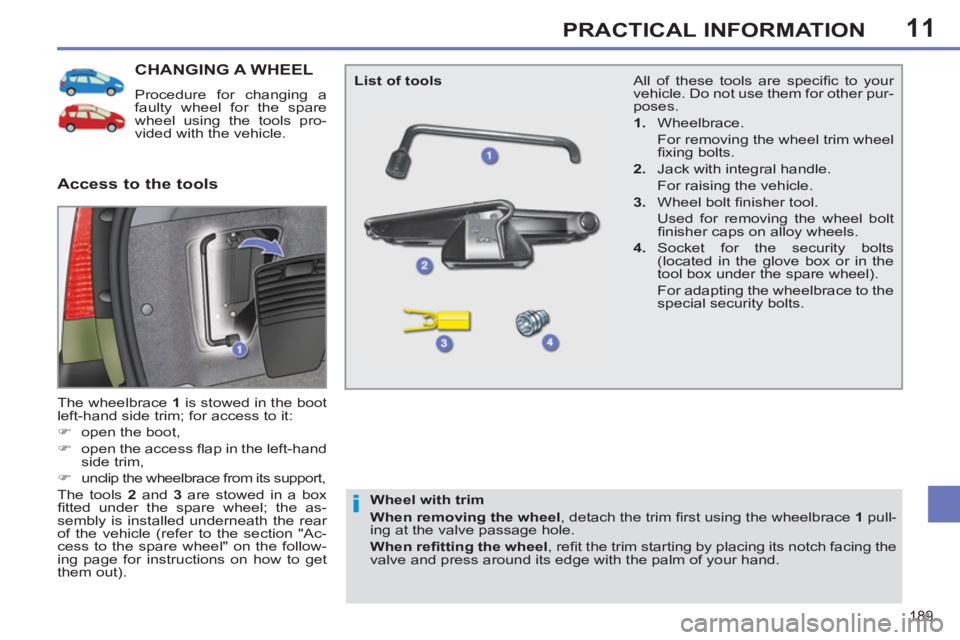
11
189
PRACTICAL INFORMATION
CHANGING A WHEEL
Procedure for changing a
faulty wheel for the spare
wheel using the tools pro-
vided with the vehicle.
The wheelbrace 1
is stowed in the boot
left-hand side trim; for access to it:
�)
open the boot,
�)
open the access fl ap in the left-hand
side trim,
�)
unclip the wheelbrace from its support,
The tools 2
and 3
are stowed in a box
fi tted under the spare wheel; the as-
sembly is installed underneath the rear
of the vehicle (refer to the section "Ac-
cess to the spare wheel" on the follow-
ing page for instructions on how to get
them out).
Access to the tools
List of tools
Wheel with trim
When removing the wheel
, detach the trim fi rst using the wheelbrace 1
pull-
ing at the valve passage hole.
When refi tting the wheel
, refi t the trim starting by placing its notch facing the
valve and press around its edge with the palm of your hand.
All of these tools are specifi c to your
vehicle. Do not use them for other pur-
poses.
1.
Wheelbrace.
For removing the wheel trim wheel
fi xing bolts.
2.
Jack with integral handle.
For raising the vehicle.
3.
Wheel bolt fi nisher tool.
Used for removing the wheel bolt
fi nisher caps on alloy wheels.
4.
Socket for the security bolts
(located in the glove box or in the
tool box under the spare wheel).
For adapting the wheelbrace to the
special security bolts.
Page 192 of 382
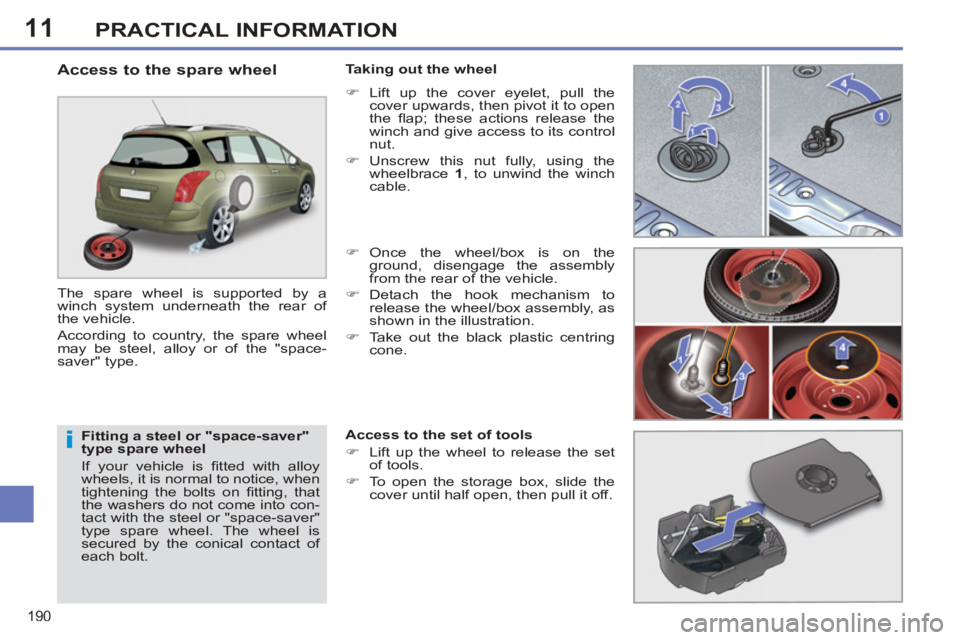
11
190
PRACTICAL INFORMATION
Fitting a steel or "space-saver"
type spare wheel
If your vehicle is fi tted with alloy
wheels, it is normal to notice, when
tightening the bolts on fi tting, that
the washers do not come into con-
tact with the steel or "space-saver"
type spare wheel. The wheel is
secured by the conical contact of
each bolt.
Access to the spare wheel
The spare wheel is supported by a
winch system underneath the rear of
the vehicle.
According to country, the spare wheel
may be steel, alloy or of the "space-
saver" type.
Taking out the wheel
�)
Lift up the cover eyelet, pull the
cover upwards, then pivot it to open
the fl ap; these actions release the
winch and give access to its control
nut.
�)
Unscrew this nut fully, using the
wheelbrace 1
, to unwind the winch
cable.
�)
Once the wheel/box is on the
ground, disengage the assembly
from the rear of the vehicle.
�)
Detach the hook mechanism to
release the wheel/box assembly, as
shown in the illustration.
�)
Take out the black plastic centring
cone.
Access to the set of tools
�)
Lift up the wheel to release the set
of tools.
�)
To open the storage box, slide the
cover until half open, then pull it off.
Page 193 of 382
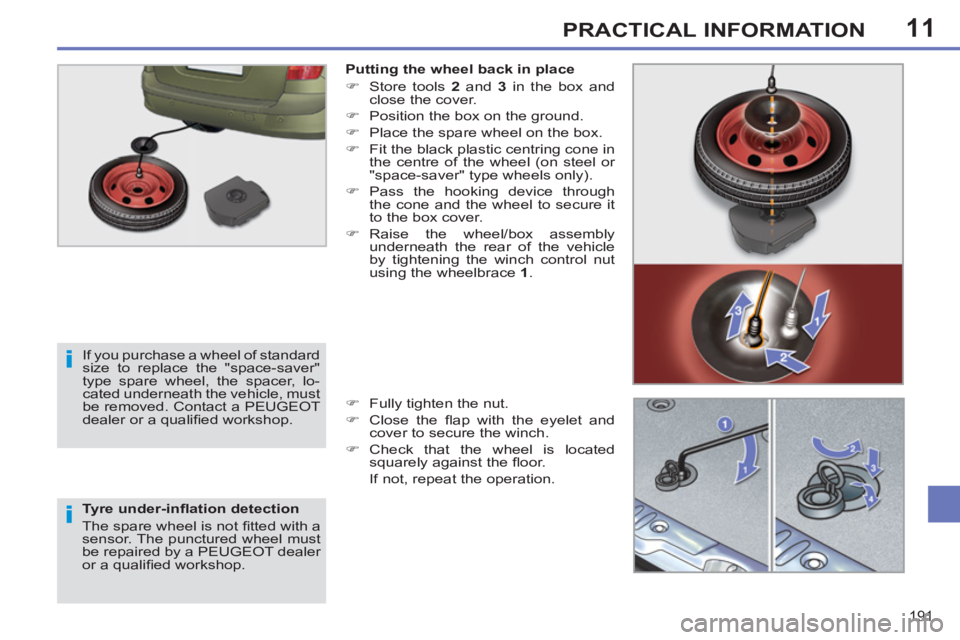
11
191
PRACTICAL INFORMATION
Tyre under-infl ation detection
The spare wheel is not fi tted with a
sensor. The punctured wheel must
be repaired by a PEUGEOT dealer
or a qualifi ed workshop.
Putting the wheel back in place
�)
Store tools 2
and 3
in the box and
close the cover.
�)
Position the box on the ground.
�)
Place the spare wheel on the box.
�)
Fit the black plastic centring cone in
the centre of the wheel (on steel or
"space-saver" type wheels only).
�)
Pass the hooking device through
the cone and the wheel to secure it
to the box cover.
�)
Raise the wheel/box assembly
underneath the rear of the vehicle
by tightening the winch control nut
using the wheelbrace 1
.
�)
Fully tighten the nut.
�)
Close the fl ap with the eyelet and
cover to secure the winch.
�)
Check that the wheel is located
squarely against the fl oor.
If not, repeat the operation.
If you purchase a wheel of standard
size to replace the "space-saver"
type spare wheel, the spacer, lo-
cated underneath the vehicle, must
be removed. Contact a PEUGEOT
dealer or a qualifi ed workshop.
Page 194 of 382
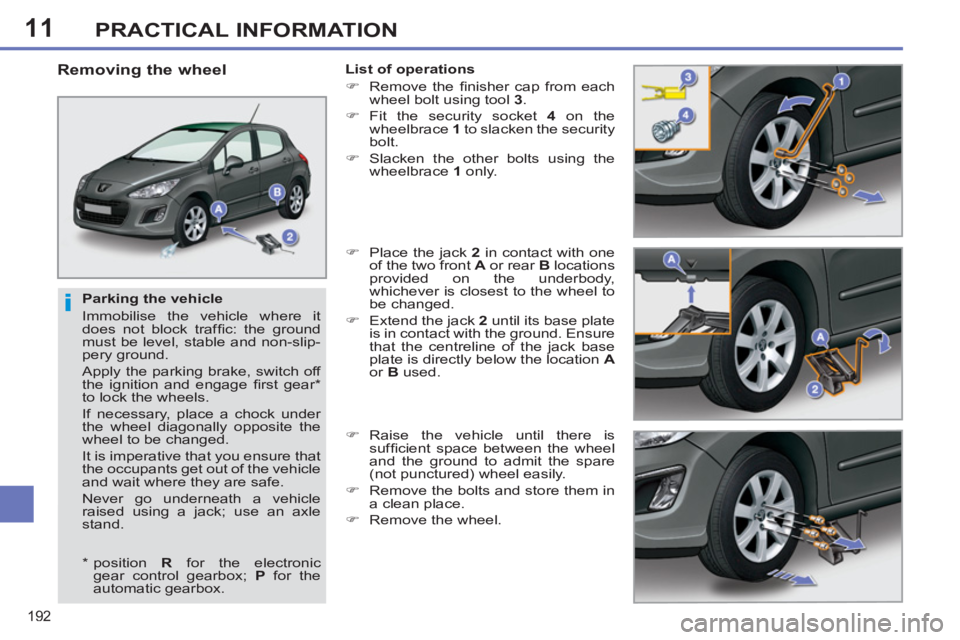
11
192
PRACTICAL INFORMATION
Parking the vehicle
Immobilise the vehicle where it
does not block traffi c: the ground
must be level, stable and non-slip-
pery ground.
Apply the parking brake, switch off
the ignition and engage fi rst gear *
to lock the wheels.
If necessary, place a chock under
the wheel diagonally opposite the
wheel to be changed.
It is imperative that you ensure that
the occupants get out of the vehicle
and wait where they are safe.
Never go underneath a vehicle
raised using a jack; use an axle
stand.
Removing the wheel
List of operations
�)
Remove the fi nisher cap from each
wheel bolt using tool 3
.
�)
Fit the security socket 4
on the
wheelbrace 1
to slacken the security
bolt.
�)
Slacken the other bolts using the
wheelbrace 1
only.
�)
Place the jack 2
in contact with one
of the two front A
or rear B
locations
provided on the underbody,
whichever is closest to the wheel to
be changed.
�)
Extend the jack 2
until its base plate
is in contact with the ground. Ensure
that the centreline of the jack base
plate is directly below the location A
or B
used.
�)
Raise the vehicle until there is
suffi cient space between the wheel
and the ground to admit the spare
(not punctured) wheel easily.
�)
Remove the bolts and store them in
a clean place.
�)
Remove the wheel.
*
position R
for the electronic
gear control gearbox; P
for the
automatic gearbox.
Page 195 of 382
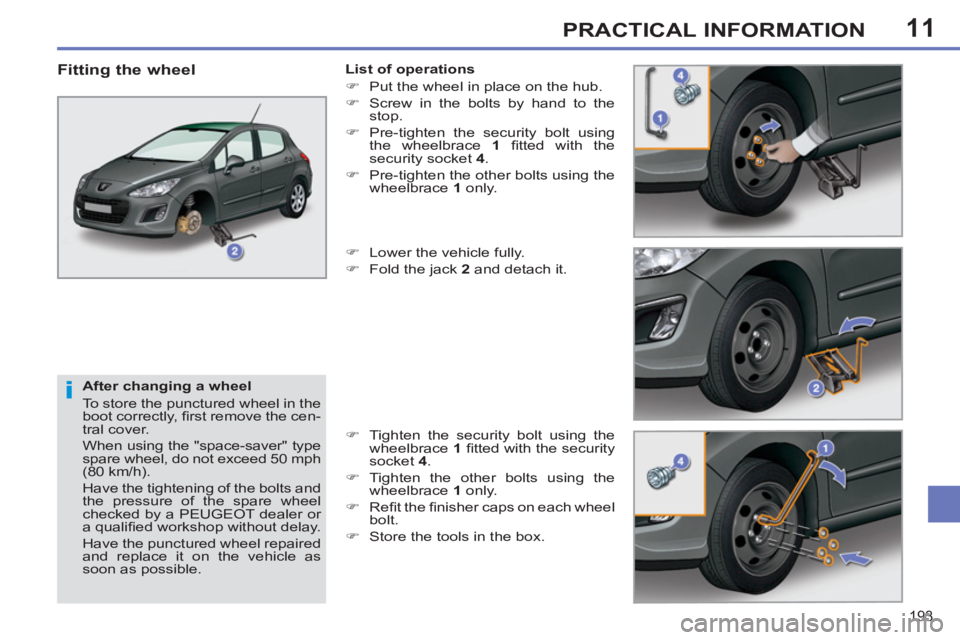
11
193
PRACTICAL INFORMATION
After changing a wheel
To store the punctured wheel in the
boot correctly, fi rst remove the cen-
tral cover.
When using the "space-saver" type
spare wheel, do not exceed 50 mph
(80 km/h).
Have the tightening of the bolts and
the pressure of the spare wheel
checked by a PEUGEOT dealer or
a qualifi ed workshop without delay.
Have the punctured wheel repaired
and replace it on the vehicle as
soon as possible.
Fitting the wheel
List of operations
�)
Put the wheel in place on the hub.
�)
Screw in the bolts by hand to the
stop.
�)
Pre-tighten the security bolt using
the wheelbrace 1
fi tted with the
security socket 4
.
�)
Pre-tighten the other bolts using the
wheelbrace 1
only.
�)
Lower the vehicle fully.
�)
Fold the jack 2
and detach it.
�)
Tighten the security bolt using the
wheelbrace 1
fi tted with the security
socket 4
.
�)
Tighten the other bolts using the
wheelbrace 1
only.
�)
Refi t the fi nisher caps on each wheel
bolt.
�)
Store the tools in the box.
Page 196 of 382
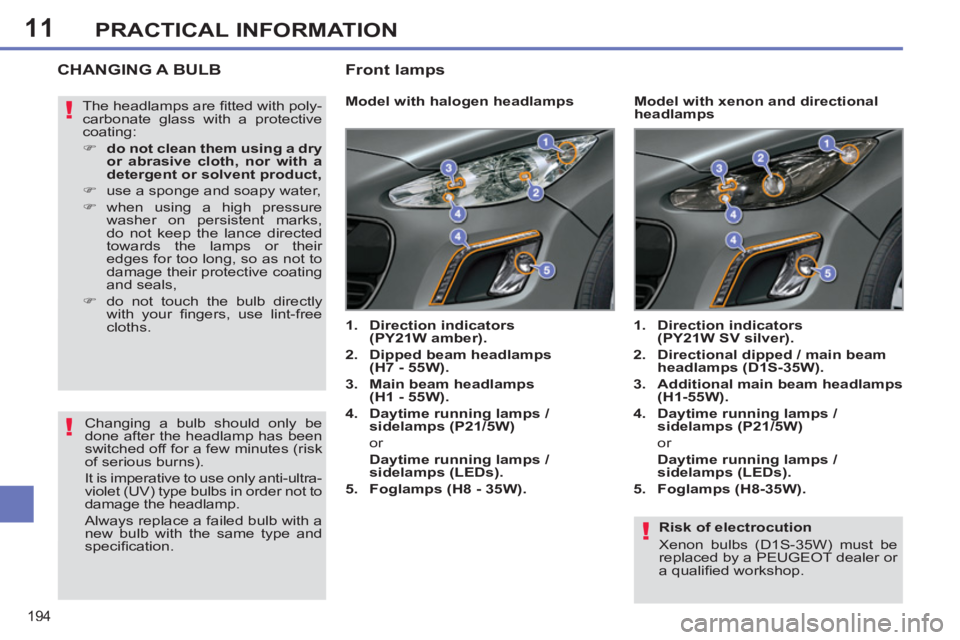
11
194
PRACTICAL INFORMATION
Risk of electrocution
Xenon bulbs (D1S-35W) must be
replaced by a PEUGEOT dealer or
a qualifi ed workshop.
CHANGING A BULB
Model with halogen headlamps
1.
Direction indicators
(PY21W amber).
2.
Dipped beam headlamps
(H7 - 55W).
3.
Main beam headlamps
(H1 - 55W).
4.
Daytime running lamps /
sidelamps (P21/5W)
or
Daytime running lamps /
sidelamps (LEDs).
5.
Foglamps (H8 - 35W).
1.
Direction indicators
(PY21W SV silver).
2.
Directional dipped / main beam
headlamps (D1S-35W).
3.
Additional main beam headlamps
(H1-55W).
4.
Daytime running lamps /
sidelamps
(P21/5W)
or
Daytime running lamps /
sidelamps (LEDs).
5.
Foglamps (H8-35W).
Model with xenon and directional
headlamps The headlamps are fi tted with poly-
carbonate glass with a protective
coating:
�)
do not clean them using a dry
or abrasive cloth, nor with a
detergent or solvent product,
�)
use a sponge and soapy water,
�)
when using a high pressure
washer on persistent marks,
do not keep the lance directed
towards the lamps or their
edges for too long, so as not to
damage their protective coating
and seals,
�)
do not touch the bulb directly
with your fi
ngers, use lint-free
cloths.
Changing a bulb should only be
done after the headlamp has been
switched off for a few minutes (risk
of serious burns).
It is imperative to use only anti-ultra-
violet (UV) type bulbs in order not to
damage the headlamp.
Always replace a failed bulb with a
new bulb with the same type and
specifi cation.
Front lamps
Page 197 of 382
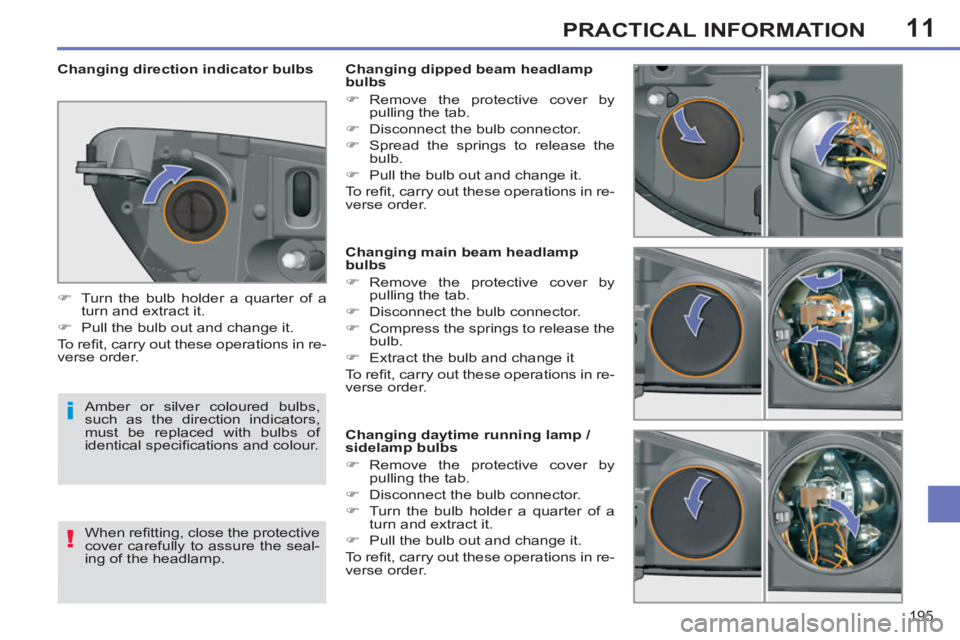
11
195
PRACTICAL INFORMATION
Changing main beam headlamp
bulbs
�)
Remove the protective cover by
pulling the tab.
�)
Disconnect the bulb connector.
�)
Compress the springs to release the
bulb.
�)
Extract the bulb and change it
To r efi t, carry out these operations in re-
verse order.
Changing daytime running lamp /
sidelamp bulbs
�)
Remove the protective cover by
pulling the tab.
�)
Disconnect the bulb connector.
�)
Turn the bulb holder a quarter of a
turn and extract it.
�)
Pull the bulb out and change it.
To r efi t, carry out these operations in re-
verse order.
Changing dipped beam headlamp
bulbs
�)
Remove the protective cover by
pulling the tab.
�)
Disconnect the bulb connector.
�)
Spread the springs to release the
bulb.
�)
Pull the bulb out and change it.
To r efi t, carry out these operations in re-
verse order.
Changing direction indicator bulbs
�)
Turn the bulb holder a quarter of a
turn and extract it.
�)
Pull the bulb out and change it.
To r efi t, carry out these operations in re-
verse order.
Amber or silver coloured bulbs,
such as the direction indicators,
must be replaced with bulbs of
identical specifi cations and colour.
When refi tting, close the protective
cover carefully to assure the seal-
ing of the headlamp.
Page 198 of 382
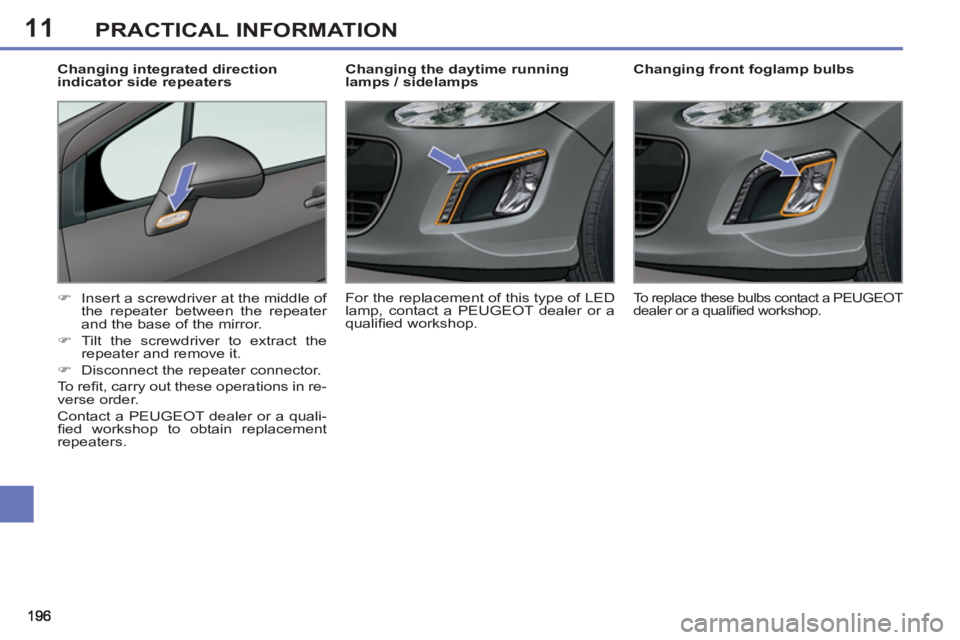
11PRACTICAL INFORMATION
Changing front foglamp bulbs
�)
Insert a screwdriver at the middle of
the repeater between the repeater
and the base of the mirror.
�)
Tilt the screwdriver to extract the
repeater and remove it.
�)
Disconnect the repeater connector.
To r efi t, carry out these operations in re-
verse order.
Contact a PEUGEOT dealer or a quali-
fi ed workshop to obtain replacement
repeaters.
Changing integrated direction
indicator side repeaters
To replace these bulbs contact a PEUGEOT
dealer or a qualifi ed workshop.
Changing the daytime running
lamps / sidelamps
For the replacement of this type of LED
lamp, contact a PEUGEOT dealer or a
qualifi ed workshop.
Page 199 of 382
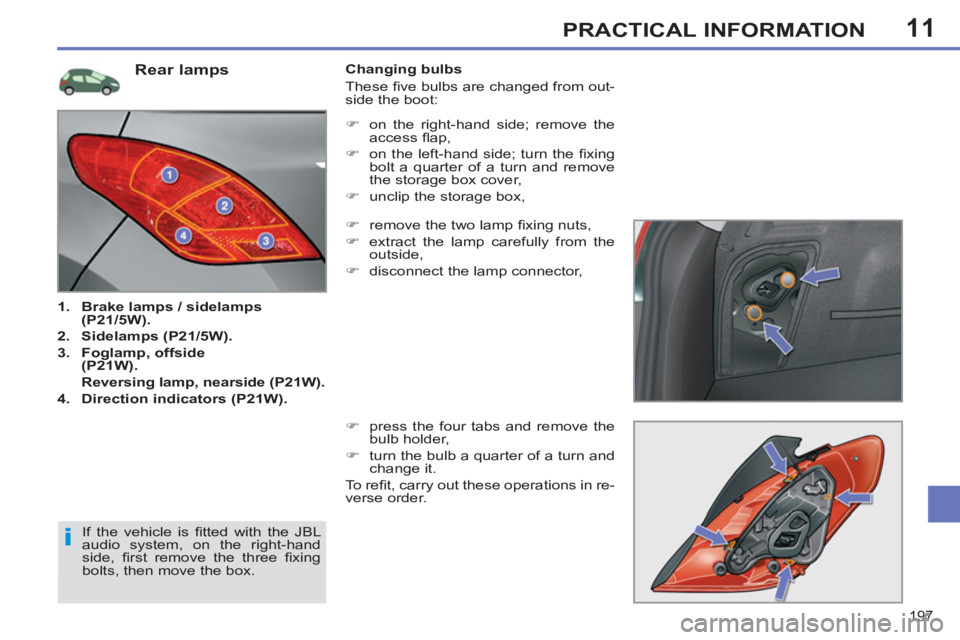
11
197
PRACTICAL INFORMATION
Rear lamps
1.
Brake lamps / sidelamps
(P21/5W).
2.
Sidelamps (P21/5W).
3.
Foglamp, offside
(P21W).
Reversing lamp, nearside (P21W).
4.
Direction indicators (P21W).
Changing bulbs
These fi ve bulbs are changed from out-
side the boot:
�)
remove the two lamp fi xing nuts,
�)
extract the lamp carefully from the
outside,
�)
disconnect the lamp connector,
�)
press the four tabs and remove the
bulb holder,
�)
turn the bulb a quarter of a turn and
change it.
To r efi t, carry out these operations in re-
verse order.
If the vehicle is fi tted with the JBL
audio system, on the right-hand
side, fi rst remove the three fi xing
bolts, then move the box.
�)
on the right-hand side; remove the
access fl ap,
�)
on the left-hand side; turn the fi xing
bolt a quarter of a turn and remove
the storage box cover,
�)
unclip the storage box,
Page 200 of 382
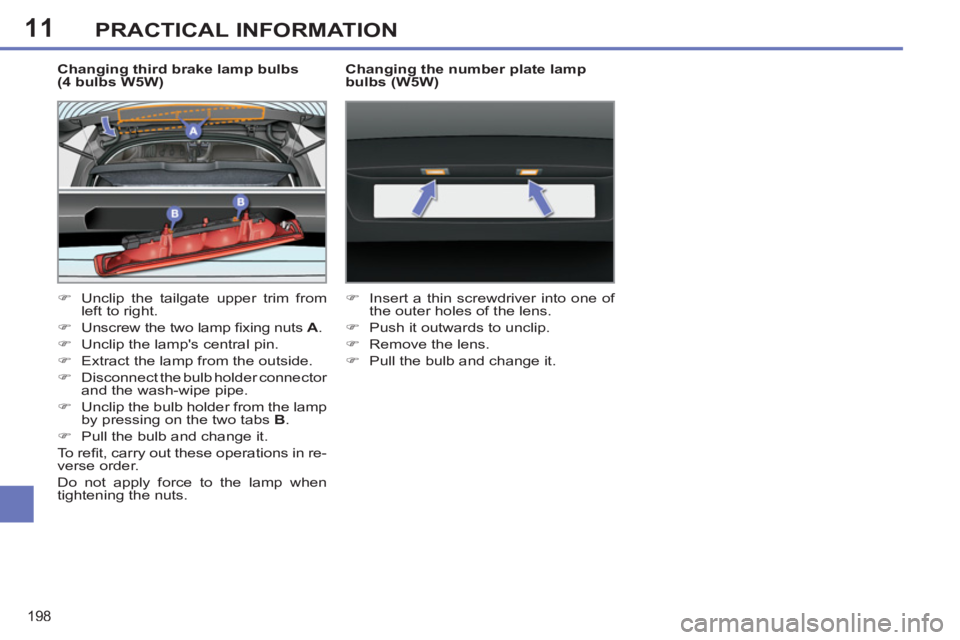
11
198
PRACTICAL INFORMATION
Changing third brake lamp bulbs
(4 bulbs W5W)
�)
Unclip the tailgate upper trim from
left to right.
�)
Unscrew the two lamp fi xing nuts A
.
�)
Unclip the lamp's central pin.
�)
Extract the lamp from the outside.
�)
Disconnect the bulb holder connector
and the wash-wipe pipe.
�)
Unclip the bulb holder from the lamp
by pressing on the two tabs B
.
�)
Pull the bulb and change it.
To r efi t, carry out these operations in re-
verse order.
Do not apply force to the lamp when
tightening the nuts.
Changing the number plate lamp
bulbs (W5W)
�)
Insert a thin screwdriver into one of
the outer holes of the lens.
�)
Push it outwards to unclip.
�)
Remove the lens.
�)
Pull the bulb and change it.